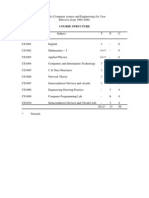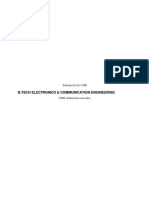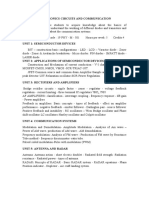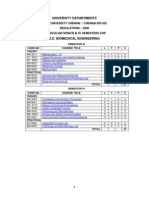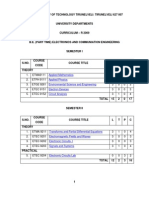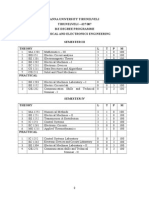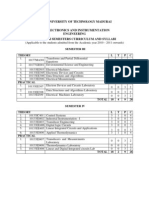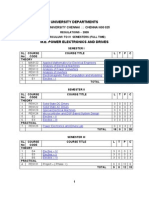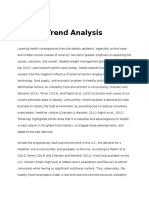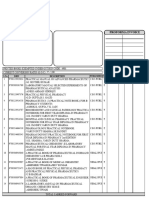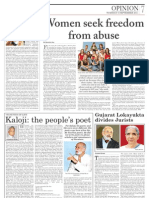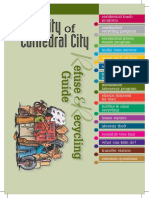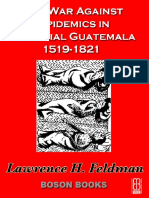University Departments: Anna University Chennai:: Chennai 600 025
University Departments: Anna University Chennai:: Chennai 600 025
Uploaded by
Malathy KrishnamoorthiCopyright:
Available Formats
University Departments: Anna University Chennai:: Chennai 600 025
University Departments: Anna University Chennai:: Chennai 600 025
Uploaded by
Malathy KrishnamoorthiOriginal Title
Copyright
Available Formats
Share this document
Did you find this document useful?
Is this content inappropriate?
Copyright:
Available Formats
University Departments: Anna University Chennai:: Chennai 600 025
University Departments: Anna University Chennai:: Chennai 600 025
Uploaded by
Malathy KrishnamoorthiCopyright:
Available Formats
UNIVERSITY DEPARTMENTS
ANNA UNIVERSITY CHENNAI : : CHENNAI 600 025
REGULATIONS - 2009 CURRICULUM I TO IV SEMESTERS (FULL TIME)
M.Sc MEDICAL PHYSICS
SEMESTER I SL. COURSE No CODE THEORY 1 MP9111 2 MP9112 3 MP9113 4 MP9114 PRACTICALS 5 MP9115 6 MP9116 COURSE TITLE Mathematical Physics Electronics Radiation Physics Non Ionizing Radiation Physics in Medicine Electronics and Instrumentation Laboratory Engineering Graphics and Workshop Practice TOTAL SEMESTER II SL. COURSE No CODE THEORY 1 MP9121 2 MP9122 3 MP9123 4 MP9124 5 E1 PRACTICALS 6 MS9125 COURSE TITLE Computational Methods in Physics Anatomy and Physiology Radiotherapy Equipments Radiation Dosimetry and Treatment Planning Elective I Diagnostic and Therapeutic Laboratory I TOTAL L 3 3 3 3 3 0 15 T 1 0 0 1 0 0 2 P 0 0 0 0 0 6 6 C 4 3 3 4 3 3 20 L 3 3 3 3 0 1 13 T 1 1 0 1 0 1 4 P 0 0 0 0 6 2 8 C 4 4 3 4 3 3 21
SEMESTER III
SL. COURSE No CODE THEORY 1 MP9131 2 MP9132 3 MP9133 4 E2 5 E3 6 MP9134 PRACTICALS 7 MP9135
COURSE TITLE Biophysics and Biomaterials Biomedical Instrumentation Brachytherapy Physics Elective II Elective III Seminar Diagnostic and therapeutic Laboratory II TOTAL SEMESTER IV
L 3 3 3 3 3 0 0 16
T 1 1 0 0 0 0 0 2
P 0 0 0 0 0 2 6 6
C 4 4 3 3 3 1 3 21
SL. COURSE No CODE THEORY 1 E4 2 E5 PRACTICAL 3 MP9141
COURSE TITLE Elective IV Elective V Project TOTAL
L 3 3 0 6
T 0 0 0 0
P 0 0 20 20
C 3 3 10 16
TOTAL CREDITS TO BE EARNED FOR THE AWARD OF THE DEGREE = 78
SL. No 1 2 3 4 5 6 7 8 9 10 11 12
COURSE CODE MP9151 MP9152 MP9153 MP9154 MP9155 MP9156 MP9157 MP9158 MP9159 MP9160 MP9161 MP9162
COURSE TITLE Biological effects of Ionizing Radiation Nuclear Medicine Advanced clinical Radiation Therapy Physics Radiation Hazards Evaluation and Control Medical Applications of Lasers Ultrasonics in Medicine Industrial Radiography Medical Imaging Techniques Monte Carlo Techniques and its Applications Environmental Pollution Control Biomedical Optical Spectroscopy Nanotechnology for Biomedical Applications
L 3 3 3 3 3 3 3 3 3 3 3 3
T 0 0 0 0 0 0 0 0 0 0 0 0
P 0 0 0 0 0 0 0 0 0 0 0 0
C 3 3 3 3 3 3 3 3 3 3 3 3
MP9111
MATHEMATICAL PHYSICS L T PC 3 1 0 4
AIM : To provide the student with the useful applications of statistics in medicine and to enable the student to recognize those applications OBJECTIVE : To provide the student with an overview of statistical thought and their respective models and methods and to provide an introduction to some of the basic computation skill 1. VECTOR CALCULUS AND MATRICES 9
Scalar and vector fields-Gradient, Divergence, Curl and Laplacian line, surface, volume integrals - Theorems of Gauss, Green and Stokes Applications, Vector operators in curvilinear co-ordinates Eigen Value, problem, diagonalisation and similarity transformation. 2. COMPLEX 9 ANALYSIS
Analytic functions-Conformal mapping-Simple and Bilinear transformationApplications-Cauchy's Integral Theorem and Integral formula-Taylor's and Laurent's series-Singularities-Zeros, Poles and Residues-Residue theoremContour integration with circular and semicircular contours. 3. FOURIER AND LAPLACE TRANSFORMS 9
Fourier series -Harmonic analysis, Fourier transform-properties-transforms of simple functions and derivatives-Convolution theorems-Laplace's transformproperties-Transform of simple functions and derivatives-periodic functionsConvolution theorem-Application to solve differential equation. 4. PARTIAL 9 DIFFERENTIAL EQUATIONS
Transverse vibration of a string-wave equation-one dimensional heat conductiondiffusion equation-two dimensional heat flow-Laplace's equation-method of separation of variables-Fourier series solution in Cartesian coordinate. 5. PROBABILITY AND STATISTICS 9
Probability concepts Binomial, Poisson, exponential and Normal Distributions Tests of hypothesis (small and large samples) based on Students t and Chi square distribution Testing goodness of fit. TUTORIALS: 15 TOTAL: 60 PERIODS
BOOKS FOR STUDY AND REFERENCE: 1. Pipes L.A. & Harvil, Applied Mathematics for Engineers and Physicists, Mc Graw-Hill Book Co., New York, 1980. 2. Mary.L.Boas, Mathematical methods in the Physical Science (2nd edition), John Wiley & Sons., New York, 1983. 3. Butkov E. Mathematical Physics, Addison Wesley, New York, 1973. 4. Walpole,E, Myers,R.M, Myers,S.L and Ye,K, Probability & Statistics for Engineers and Scientists, Pearson Education, 2002. 5. Sathyapraksh, Mathematical Physics, Sultan chand & Co., New Delhi, 1994. 6. M.K. Venkatraman, Advanced Mathematics for Engineers & Scientists, National Publishing co., Madras, 1994. 7. G. Arfken and H.H. Weber, Mathematical Methods for Physicists, 4th edition, Prism Books, Bangalore, 1995.
MP9112 AIM :
ELECTRONICS L TPC 3 1 0 4
To understand the importance of electronics today, which provides the world with an infinite amount of information at a much faster speed than that information would ever have been available before. OBJECTIVE : To provide information and make the student understand the need for electronics in designing process and presentation tools in medical field. 1. ANALOG ELECTRONICS I: 9 Op-amp introduction input modes and parameters op-amps with negative feedback open-loop response mathematical operations analog simulation-OTAs CFOAs active filters oscillator circuits oscillator with RC feedback circuits (RC and LC) relaxation oscillators linear and nonlinear oscillators 555 timer as an oscillator IC voltage regulators Evolution of ICs CCDs. 2. ANALOG ELECTRONICS II: 9
Op-amp comparators and controls-noise in comparator circuits zero crossing detectors with hysteresis voltage level detectors precision comparators-biomedical application-window detector-voltage to current converters current to voltage converters-current amplifier temperature to voltage converters-multivibratorsclipping and clamping circuits- D/A and A/D converters. 3. TRANSDUCER: 9
Classification selection of a transducer Strain gauge Displacement transducer (Capacitive, inductive, differential transformer, photo electric and Piezoelectric transducers) Strain flow measurements Thermistor and thermo couple based thermometers for measuring temperature. 4. DIGITAL ELECTRONICS 9
Introductory digital concepts-overview of logic functions fixed function integrated circuits- programmable logic devices FPGAs functions of combinational logic flip flops and related devices counters shift registers memory and storage Introduction to microprocessors, computers and buses integrated circuit technologies. 5. ELECTRONICS FOR NUCLEAR DEVICES 9
Preamplifier A.D-DC converter pulse shaper isolator high range gamma survey meter circuit scintillation dose rate meter scintillator photodiode x-ray detector pocket monitor general purpose contamination monitor discriminator single channel analyzer linear gate time to amplitude converter. TUTORIALS: 15 TOTAL: 60 PERIODS
BOOKS FOR STUDY AND REFERENCE:
1. P.Horowitz and W.Hill, The art of electronics, (2nd edition), Cambridge
university press, Cambridge, 1995. 2. A.P.Malvino, Electronic principles, (6th edition), Tata McGraw Hill Publ.Co. Ltd., New Delhi, 1999. 3. T.L.Floyd, Electronic devices, (6th edition), pearson Education Inc., New Delhi, 2003 4. R.F.Coughlin and F.F.Driscoll,Operational amplifiers and linear integrated circuits, (6th edition), Pearson Education Inc., New Delhi, 2001. 5. M.Lakshmanan and K.Murali, Chaos, Chaos in nonlinear Ocillators, World Scientific Singapore, 1996. 6. T. L. Floyd, Digital Fundamentals, (8th deition), pearson education Inc., New Delhi, 2003. 7. S.Brown and Z.Vranesic,Fundamentals of digital logic with Verilog design, Tata McGraw Hill Publ Co.Ltd., New Delhi, 2003. 8. H.Skalsi, Electronic instrumentation (2nd edition), Tata McGraw Hill Publ. Co. Ltd., New Delhi,2004
MP9113
RADIATION PHYSICS L TPC 3 004
AIM: The material in this section is designed to teach the basics of radiological physics OBJECTIVE: To understand the interaction of radiation with matter with emphasis on energy transfer and dose deposition. To understand exponential attenuation under narrow and broad beam conditions, to better understand shielding design in health physics. 1. ATOMIC STRUCTURE 9 Structure of matter - atom - nucleus -atomic mass and energy units -distribution of orbital electrons - atomic energy levels -nuclear forces -nuclear energy levelsparticle radiation -Electro magnetic radiation- Binding energy - General properties of alpha, beta and gamma rays.
2. NUCLEAR TRANSFORMATIONS 9 Laws of equilibrium - Theory of alpha, beta decay and gamma emission - electron capture - internal conversion - nuclear isomerism -nuclear reactions - natural and artificial radioactivity - reactor and cyclotron produced isotopes - fission products.
3. INTERACTION OF RADIATION WITH MATTER 9 Ionization - Thomson Scattering-photoelectric and Compton process and energy absorption - pair production - Attenuation coefficient and mass energy absorption coefficient - relative importance of various types of interactions - interaction of charged particles with matter - interaction of neutron with matter - scattering - capture - neutron induced nuclear reaction.HVL,TVL 4. DOSIMETRIC CONCEPTS AND QUANTITIES 9 Introduction -exposure-Roentgen - photon fluence and energy fluence -KERMAKerma and absorbed dose -CEMA -Absorbed dose -stopping power - relationship between the dosimetric quantities - cavity theory. Bremsstrahlung radiation, Braggs curve. 5. RADIATION DOSIMETERS 9 Introduction - Properties of dosimeters - Theory of gas filled ionization chamber - GM counter - working and different uses - recovery time and dead time - quenching scintillation detectors - ionization chamber dosimetry systems - film dosimetry luminescence dosimetry - semiconductor dosimetry - diamond dosimetry Gel dosimetry - primary standards. TOTAL : 45 PERIODS BOOKS FOR REFERENCE: 1. Radiation oncology physics : A Handbook for teachers and students. IAEA publications 2005. 2. F.M.Khan,The Physics of Radiation Therapy,Third Edition,Lippincott Williams and Wilkins,U.S.A.,2003. 3. H. E. Jones, J. R. Cunningham, The Physics of Radiology, Charles C. Thomas, New York, 2002. 4. W. J. Meredith and J. B. Massey, Fundamental Physics of Radiology, John Wright and Sons,U. K., 2000. 5. W. R. Handee, Medical Radiation Physics, Year Book Medical Publishers Inc.,
London, 2003. MP9114 AIM : Focused on filling the need for a "basic physics" understanding of non ionizing radiations -tissue interactions. OBJECTIVE: This paper brings together contributions from various medical specialties such as ophthalmology, dermatology and their interaction mechanisms with that of Optical radiations , IR radiations and sound. 1. REVIEW OF NONIONISING RADIATIONPHYSICS IN MEDICINE 9 NON IONIZING RADIATION PHYSICS IN MEDICINE L T P C 3 1 0 4
Different sources of Non Ionising radiation-their physica; properties- first law of photochemistry-Law of reciprocity- - Electrical Impedance and Biological Impedance - Principle and theory of thermography - applications 2 TISSUE OPTICS 9
Various types of optical radiations - UV, visible and IR sources - Lasers: Theory and mechanism- Laser Surgical Systems-Measurement of fluence from optical sources - Optical properties of tissues theory and experimental techniquesinteraction of laser radiation with tissues photothermal -photochemical photoablation electromechanical effect 3. MEDIPHOTONICS 9
Lasers in dermatology, oncology and cell biology - Application of ultrafast pulsed lasers in medicine and biology - Lasers in blood flow measurement -- Fiber optics in medicine - microscopy in medicine - birefringence - Fluorescence microscope - confocal microscope - Hazards of lasers and their safety measures. 4. MEDICAL ULTRASOUND 9
Production, properties and propagation of ultrasonic waves - Bioacoustics Acoustical characteristics of human body- Ultrasonic Dosimetry - Destructive and nondestructive tests - Cavitation - Piezo electric receivers, thermoelectric probe Lithotropy - -High power ultrasound in theraphy 5. RADIOFREQUENCY AND MICROWAVE 9
Production and properties - interaction mechanism of RF and mirocwaves with biological systems: Thermal and non-thermal effects on whole body, lens and cardiovascular systems tissue characterization and Hyperthermia and other applications. Biomagnetism - Effects - applications. TUTORIALS: 15 TOTAL: 60 PERIODS
BOOKS FOR STUDY AND REFERENCE: 1. S. S. Martellucci and A. N. Chester, Laser Photobiology and Photomedicine, Plenum Press, New York, 1985. 2. Markolf H. Neimz, Laser-Tissue Interactions, Springer Verlag, Germany, 1996. 3. J. P. Woodcock, Ultrasonic, Medical Physics Handbook series 1, Adam Hilger, Bristol, 2002. 4. J. R. Greening, Medical Physics, North Holland Publishing Co., New York, 1999. 5. R. Pratesi and C. A. Sacchi, Lasers in Photomedicine and Photobiology, Springer Verlag, West Germany, 1980.
MP9115 AIM :
ELECTRONICS AND INSTRUMENTATION LABORATORY L T PC 0 0 6 3
To understand the importance of electronics today, which provides the world with an infinite amount of information at a much faster speed than that information would ever have been available before. OBJECTIVE : To provide information and make the student understand the need for electronics in designing process and presentation tools in medical field. ATLEAST FIFTEEN EXPERIMENTS 1. 2. 3. 4. 5. 6. 7. 8. 9. 10. 11. 12. 13. 14. 15. 16. 17. 18. 19. 20. Determination of Young's Modulus of bone and bone equivalent materials. Bridge Rectifier - Ripple factor, percentage of regulation. Dual regulated power supply Astable multivibrator Abbe's refractometer Logic gates Operational Amplifier - Characteristics of summer, difference amplifier and integrator Filters - high pass, low pass and band pass X-ray powder diffraction method Copper arc spectrum G. M. Counter Microprocessor Intel 1086 Guoy balance Gamma ray spectrometer IC regulated power supply Discriminator and multivibrator Univibrator Binary counters Digital to Analog and Analog to Digital conversion Digital circuits for measurements
10
MP9116
ENGINEERING GRAPHICS AND WORKSHOP PRACTICE LTPC 1034
1. ENGINEERING GRAPHICS
15
Drawing Instruments and their uses, lines, lettering and dimensioning orthographic projections section of solids, Isometric projections Isometric views of simple objects such as square, cube and rectangular blocks Free hand sketching of nuts, bolts, rivets and washers with dimensions, from samples BIS standards and codes elementary treatment) 2. WORKSHOP PRACTICE: a) Demonstration of basic manufacturing process like Welding, Foundry and sheet metal b) Lathes: Apron mechanism, different work holding devices, different operation, Machining time calculations. c) Milling machine: Mechanism - different work holding devices, different operation, calculations part d) Drilling machine: Mechanism Operations Calculation part e) Shaper Machines: Quick return mechanism Different work loading Devices -different operations Calculation part. f) Process planning and cost estimation of simple components Elementary treatment. g) Introduction to CNC Machines Machining centres and turning centres BOOKS FOR STUDY AND REFERENCE: 1. N.D.Bhatt, Elementary Engineering drawing, Character publishing co. 1990. 2. Hajna Choudhry, Elements of Workshop Technology, Vol. I and II, Media Promoters and publishers Pvt. Ltd., Mumbai, 2001. 3. R.K.Jain and S.C.Gupta, Production Technology, Khanna Publishers, 16th Ed,2001. 4. Serope Kalpajion, Stevan R. Schmid, Manufacturing Engineering and Technology, Prasson Education, Inc., 2002 (Second Indian Print). 5. Radhakrishnan, C.N.C. Machines, New Central Book Agency, 1992 6. Bernard Hodges, CNC Part programming work book, City and Guilds. MacMillan, 1994 7. Hajra Choudry, S.K., Elements of Workshop Teaching, Vol.I and II, Tata McGraw ill Publishing Co., New Delhi, 1992.
11
MP9121
COMPUTATIONAL METHODS IN PHYSICS L TPC 3 1 0 4
AIM: Computer application is an essential component of the various tools that a medical physicist needs to perform tasks in practice. OBJECTIVE: To provide the students with the knowledge on matrix, interpolation, Differential equations and bio statistics. Design the experiments, surveys and acquisition analysis interpretation presentation from empirical studies. 1. SOLUTIONS OF EQUATIONS 9
Roots of equations - Methods of bisection & false position - Newton-Raphson method - Simultaneous equations - Gauss elimination - Gauss Jordan methods matrix inversion and LU decomposition method - Gauss-Seidel iterative method Eigenvalues of matrices - Power method, Jacobi's method. 2. INTERPOLATIONS 9
Finite differences- Forward Backward- Central differences-Newton-Gregory forward, backward interpolation Formulae for equal intervals-Missing termsLagranges interpolation formula for unequal intervals-Inverse interpolations. 3. DIFFERENTIATION, INTEGRATION AND DIFFERENTIAL EQUATIONS 9
Newton's forward and backward difference formulae - Numerical integration Trapezoidal rule and Simpson's rule - Numerical solution of ordinary differential equations - Taylor series - Euler's method, improved and modified methods Runge-Kutta methods - Milne's predictor -corrector method
4. CURVE FITTING AND DISCRETE FOURIER TRANSFORMS
Curve fitting - Principle of least squares - Discrete Fourier Transform - Fast Fourier Transform - Applications Random waveforms and noise. 5. C-PROGRAMMING 9
Structure pointers types of variables-arrays-functions (intrinsic and user defined) arithmetic operations and shorthand notations loops (do, for, if loops) elementary examples of programs (three programs at least from each of the above units)
TUTORIALS: 15 TOTAL: 60 PERIODS BOOKS FOR STUDY AND REFERENCE:
12
1. M.K.Venkatraman, "Numerical Methods in Science and Engineering", National Publishing Company, Madras, 1996 2. S.S.Sastry, "Introductory Methods of Numerical Analysis", Prentice Hall of India, New Delhi, 1992 3. Bracewell,R.N, The Fourier Transform and its applications, McGraw Hill International Edition, 2000 4. Dey,P and Ghosh,M, Programming in C, Oxford University Press, 2007. MP9122 ANATOMY AND PHYSIOLOGY LT PC 3 0 0 3 AIM: Make the student able to interpret common medical terminology from knowledge of Greek and Latin root words OBJECTIVE : To identify gross anatomical structures define the major organ systems, the physiologic mechanisms for repair, maintenance and growth, In order to correlate with the imaging modalities used to view them 1. DEFINITIONS 9 Applications, History- Cells, structure and functions, sex cells, early development The tissues - the systems - skin, cartilage and bone - Bacteria - Inflammation injection - ulceration - neoplasm, bones - the skeleton - joints - The skeletal system the skull - vertebral column, thorax etc. - the muscular system - the thoracic cage the mediastinum, the diaphragm the abdominal cavity and abdominal regions anatomy of the heart. 2. DIGESTIVE SYSTEM 9 Functions of mouth, tongue, teeth, esophagus, stomach, small intestine, large intestine - digestion and assimilation of carbohydrates - Fats and proteins - Gastric juice - Pancreatic juice - Function of liver and spleen, blood and circulatory system, Blood and its composition, RBC and WBC - blood grouping - coagulation of blood, artery, vein, capillaries and heart structure and functions - Physiological properties of heart muscle, cardiac dynamics - EEG - blood pressure and its regulation. 3. RESPIRATORY, REPRODUCTION AND EXCRETORY SYSTEMS 9 Physical laws of respiration - Trachea - lungs and its functions - oxygen transport nervous regulation of respiration. Hormonal control over reproduction. Kidney and its functions - water and electrolyte metabolism. 4. ENDOCRINE SYSTEM 9
Pituitary glands and its functions - functions of adrenal, thyroid etc. secretion chemistry - physiological actions, effect on removal effect on administration, hormonal assay detailed molecular mechanism of hormone action. 5. NERVOUS SYSTEM 9 Brain and spinal cord - its functions - central nervous system and Autonomic Nervous system functions - Physiology of special senses of hearing, taste vision etc.
13
TOTAL : 45 PERIODS BOOKS FOR STUDY AND REFERENCE: 1. C. H. Best and N. B. Taylor, A Test in Applied Physiology, Williams and Wilkins Company, Baltimore, 1999. 2. C. K. Warrick, Anatomy and Physiology for Radiographers, Oxford University Press, 2001. 3. J. R. Brobek, Physiological Basis of Medical Practice, Williams and Wilkins, London, 1995.
14
MP9123
RADIOTHERAPY EQUIPMENTS LTPC 3 0 0 3
AIM: It is designed to familiarize the students with various radiation therapy equipments. OBJECTIVE: To understand the physical design, maintenance and quality assurance of tele cobalt, Linear accelerators and other radiation therapy equipments 1. TELEGAMMA MACHINES 9
Co-60 and Cs-137 as teletherapy sources - source containers - international source capsule - effect of penumbra- Types of collimators - beam directing devices Different Source Shutter Systems-Quality Assurance of telegamma units. 2. LINEAR ACCELERATORS 9
Components of modern linear accelerator-Standing and travelling wave guides, Magnetrons and Klystrons. Bending Magnet, Target, Flattening filter, Collimators. Need for high quality portal imaging - Fluoroscopic, diode, crystal, Ionization chamber detectors and film detectors, amorphous silicon - Diagnostic imaging on a linear accelerator - portal dose images, Portal Dosimetry. Telecobalt Vs Linacs. 3. RADIOTHERAPY SIMULATORS 9
Conventional simulators - CT simulators - cone beam CT simulators (CBCT) comparison and quality assurance of simulators - different simulation techniques Orthogonal, Semi-orthogonal, Isocentric, Variable angle and Stereo-Shift. 4. BRACHYTHERAPY 9
9 Introduction - Manual pre loading systems- manual after loading systems - remote after loading systems -source trains( fixed and programmable) - stepping source different types of applicators( gynecological ,esophageal, nasopharngeal, bronchial) and templates Introduction to computerized brachytherapy planning. 5. ADVANCED RADIOTHERAPY EQUIPMENTS 9
Superficial X-ray therapy units - Gamma knife - cyber knife - Intra operative radiation therapy units- Tomotherapy -Neutron therapy - boron neutron capture therapy (BNCT)-particle accelerators - proton therapy - carbon ion therapy. TOTAL : 45 PERIODS BOOKS FOR REFERENCE: 1. Radiation oncology physics : A Handbook for teachers and students. IAEA publications 2005.
15
2. F.M.Khan,The Physics of Radiation Therapy,Third Edition,Lippincott Williams and Wilkins,U.S.A.,2003 3. Photodynamic therapy, By Thierry Patrice Published by Royal Society of Chemistry, 2004 4. Medical Applications of Lasers By D. R. Vij, K. Mahesh Published by Springer, 2002 5. Watmough and Ross, Hyperthermia, Blackie 1986 MP9124 RADIATION DOSIMETRY AND TREATMENT PLANNING L T PC 3 1 0 4 AIM: Paper is designed to provide the knowledge of charged particles and radiation equilibrium and their related theories. OBJECTIVE : To make the student understand the various calibration techniques for teletherapy units, Treatment planning algorithims and to study the practical dosimetry with ion chambers and several common condensed dosimeters. 1. CALIBRATION OF TELETHERAPY UNITS 9 IAEA TRS 398 protocol for the calibration of teletherapy units - comparison with earlier protocals - calibration for the cobalt telegamma units - cross calibration of the chambers -calibration of High Energy photon beams - calibration for electron beams. IAEA TLD postal inter comparison. 2. BEAM DATA MEASUREMENTS and QUALITY ASSURANCE 9 Measurements of percentage depth dose and profiles - photon beams and electron beams- use of various detectors in relative dosimetry - measurements of conventional and dynamic wedge profiles - Quality Assurance of treatment planning systems IAEA TRS 430 protocol 3. RADIATION TREATMENT PLANNING PARAMETERS 9 Build-up, central axis depth doses for different energies and their determination Tissue Air Ratio, Tissue Maximum Ratio and Tissue Phantom Ratio - their relationship - back scatter factor -phantom scatter factor -collimator scatter factor source to surface distance -dependence of SSD- isocentre -SAD treatment techniques. 4. PLANNING ALGORITHMS 9 Photon beam algorithm-Pencil Beam Algorithm, Collapsed Cone Convolution, Analytical Anisotropic Algebraic Algorithm - Monte carlo -Comparison of algorithms -generalized pencil beam algorithms and electron montecarlo algorithms - dose calculation algorithms in brachytherapy. 5. TREATMENT PLANNING ASPECTS 9 Treatment positioning - immobilization -Patient data acquisition from CT and MRI registration - fusion - contouring - delineation of tumour volumes- correction for contour irregularities - correction for body inhomogenities- tissue compensation wedge filters - blocks - Overview of Conventional ,Conformal and IMRT treatment planning. TOTAL : 45 PERIODS BOOKS FORREFERENCE: 1. F M Khan-Physics of Radiation Therapy, 3rd Edition,Liippincott Williams & Wilkins,USA, 2003.
16
2. W. R. Hendee, Medical Radiation Physics, Year Book Medical Publishers
3.
Inc.,
London, 2003. R. F. Mould, Radiotherapy Treatment Planning, Medical Physics Hand Book Series No. 7, Adam Hilger Ltd., Bristol, 1981. 4. Khan, Faiz M. Treatment Planning in Radiation Oncology, 2nd Edition Lippincott Williams & Wilkins, 2007 MP9125 DIAGNOSTIC AND RADIATION THERAPEUTIC LABORATORY- I LT PC 0 0 63 AIM : It is concerned with the use of various imaging modalities to aid in the diagnosis of disease. Interventional radiology uses these imaging modalities to guide minimally invasive surgical procedures. OBJECTIVE : To make the students enable to get the hand on experience to draw the contours for planning effective treatment of cancer. 1. Calibration of telecobalt unit using water phantom. 2. Field congruence test for telecobalt and the linear accelerator. 3. Calibration of the high energy photon beams using water phantom. 4. Calibration of the electron beams using water phantom. 5. External Beam Treatment Planning -conventional 6. Calibration of the high dose rate source using well-type chamber. 7. Brachytherapy planning for mannual after loading applicator using CS-137 8. Brachytherapy planning for HDR remote after loading treatment 9. Cross calibration of the ionization chamber. 10. Percentage depth dose and profile measurements using RFA. 11. ECG preamplifier 12. Bridge amplifier 13. Ultrasonic diffraction instruments 14. Pacemaker I 15. Pacemaker II 16. TLD Dosimeter 17. obsorption characterisitcs using UV VIsible spectrophotometer 18. Fluorescence spectrum using spectrofluorometer 19. GM Counter characterisitcs 20. Estimation of pH value for different physiological fluids 21. Laser speckle optometer 22. Determination of composition of materials in bones using spectroscopic methods 23. Determination of composition of materials in bones using X-ray methods
17
TOTAL : 45
18
MP9131 AIM:
BIOPHYSICS AND BIOMATERIALS L T PC 3104
To emphasizes the importance of different biomaterials in application to problems in biology and medicine. OBJECTIVE: To equip the students with the knowledge on different kinds of biomaterials and other medical need , basic research, and to provide an over view of theory and practice of bio materials. 1. CHEMICAL BINDING AND BONDS 9 Quantum mechanics Schrodingers time dependent and independent equations Paulis exclusion principle ionization energy electron affinity chemical binding electronegativity and strong bonds- secondary bonds interatomic potential for strong bonds and weak bonds non control forces bond energies spring constants free energy internal energy reaction kinetics. 2. TECHNIQUES TO STUDY BIOMOLECULES 9 X-ray diffraction and molecular structure Nuclear Magnetic Resonance scanning tunneling microscope Atomic force microscopy optical tweezers patch clamping molecular dynamics potential energy contour tracing SEM TEM spectroscopy methods differential thermal analysis, differential thermo gravimetric analysis NDT methods. 3. PHYSICS OF BIOMATERIALS AND THEIR PERFORMANCE 9 Crystal Structure of matter - physical properties, mechanical properties of biomaterials - Biofunctionality and biocompatibility material response-function and degradation of materials and host response biological effects of implants. 4. ARTIFICIAL ORTHOPEADIC AND DENTAL MATERIAL 9 Materials for bone and joint replacement dental metals and alloys ceramic bioinert bioactive ceramics polymers Nano Biomaterials -matrix and filler materials dental restorative materials dental amalgams. 5. CARDIOVASCULAR MATERIALS AND OTHER MATERIALS 9 Artificial organs cardiovascular materials cardiac prosthesis; vascular graft materials cardiac pacemakers cardiac assist devices materials for ophthalmology contact lens intraoccular materials materials for drug deliveryelementary idea on Stem cells in organ repair. TUTORIALS: 15 TOTAL: 60 PERIODS BOOKS FOR STUDY AND REFERENCES: 1. Rodney M J Cotterill, Biophysics an introduction, John Wiley & sons Ltd., NY, 2002 2. Vasantha Pattabhi and N.Gautham, Biophysics, Alpha science International Ltd. UK, 2002. 3. Jonathan Black, Biological Performance of materials, Fundamentals of Biocompatibility, Marcel Dekker Inc., New York, 1992. 4. D. F. Williams (editor), Material Science and Technology - A comprehensive treatment, Vol. 14, Medical and Dental Materials, VCH Publishers Inc., New York, 1992.
19
5. H. H. Willard, L. L. Merritt, J. A. Dean and F. A. Settle, Instrumental Methods of Analysis, CBS Publishers, New Delhi, 1986. MP9132 BIOMEDICAL INSTRUMENTATION LT PC 3 1 0 4 AIM: To make the students to familiarize physical design , Maintenance of different biomedical instrument used in medical field. OBJECTIVE: To enable the student to understand the physics and theory behind the bio electric signal recording, physiological assist devices, operation theater equipments and biotelemetry and their safety measures. 1. BIOPOTENTIAL ELECTRODES AND TRANSDUCERS 9
Cell structure-nature of cancer cells - Transport of ions through cell membrane Resting and action potential - half cell potential - bioelectric potential - design and co;mponents of medical insturments - electrodes - surface, needle, depth electrodes - electrical circuits - Transducers. 2. BIOELECTRIC 9 SIGNAL RECORDING
Introduction - characterstics of recording systems - Electrodcardiography (ECG) Electroencephalograph (EEG)- electromyograph (EMG)- electroneurograph (ENG) recoring units. 3. PHYSIOLOGICAL ASSIST DEVICES 9
Cardiac pacemakers - natural and artificial pacemakers - pacemaker batteries defibrillator - A. C./D. C. synchronized defibrillator - stimulators - bladder stimulators heart lung machine various types of oxygenators - kidney machine - hemodialysing units - peritoneal dialysis. 4. CLINICAL AND OPERATION THEATER EQUIPMENTS 9
Flame Photometer - Spectroflurometer - pH meters - Audiometer - endoscopes Electromagnetic and laser blood flow meters - ventilators - diathermy units ultrasonic, microwave diathermy techniques. 5. BIOTELEMETRY 9 AND SAFETY INSTRUMENTATION
Design of a biotelemetry system: radiotelemetry with subcarrier - multiple channel telemetry systems - problems in implant telemetry - uses of biotelemetry physiological effects of 50Hz current - microshock and macroshock - electrical accidents in hospitals - devices to protect against electrical hazards. TUTORIALS: 15 TOTAL: 60 PERIODS BOOKS FOR STUDY AND REFERENCE: 1. M. Arumugam, Biomedical Instrumentation, Anuradha Publishing Co., Kumbakkonam, Tamilnadu, 2004. 2. Jacobson and Webster, Medicine and clinical Engineering, Prentice Hall of India, New Delhi, 1979.
20
3. R. S. Khandpur, Handbook of Biomedical Instrumentation, Tata McGraw Hill, New Delhi, 1990. 4. Richad Aston, Principles of Biomedical Instrumentation and measurement, Merrill Publishing Co., London, 1990. MP9133 BRACHYTHERAPY PHYSICS LTPC 3 0 0 3 AIM: To provide the student with the overall view of the brachytherapy modalities in the management of cancer. OBJECTIVE: To make the student understand the physical characteristics and clinical methodology of short distance treatment methods like interstitial, intracavitary and surface applications 1. PHYSICS OF BRACHYTHERAPY 9
Evolution of brachytherapy -different types of brachytherapy- based on the dose rate, (LDR, MDR, HDR, PDR) based on techniques (Intracavity, interstitial, intraluminal and surface mould ) - temporary and permanent implants 2. RADIONUCLIDES AND THEIR PROPERTIES 9
Introduction - properties of ideal radionuclide - production and construction of sealed source - Radium (needles), Cobalt -60(HDR and LDR), Cesium -137(LDR), Gold198(LDR seeds), Iridium-192(HDR and LDR), Iodine-125 (LDR seeds), Cesium131(LDR seeds) - Californium-252 3. DOSIMETRY 9
Source specification - source calibration using in air set up, well-type chambers and solid phantoms.- self absorption and attenuation in sources - TG43 dosimetry formalism -Monte Carlo based source dosimetry- manual dosimetric calculations -Manchester, Quimby and Paris systems - ICRU - 38 and 58- optimization methodsQuality Assurance. 4. ADVANCED BRACHYTHERAPY SYSTEMS 9
Partial breast irradiation using balloon catheter - Intra-operative Brachytherapy -Integrated Brachytherapy unit - electronic brachytherapy - micro brachytherapy. 5.NON ONCOLOGICAL APPLICATIONS 9
Introduction - Intravascular brachytherapy - sources used for intravascular brachytherapy- delivery devices-current status-Strontium-90 Opthalmic applicatorsTreatment planning and delivery. TUTORIALS: 15 TOTAL: 60 PERIODS BOOKS FOR REFERENCE: 1. The physics of modern brachytherapy for oncology, D Baltas, Taylor and Francis.2007.
21
2. F.M.Khan,The Physics of Radiation Therapy,Third Edition,Lippincott Williams and Wilkins,U.S.A.,2003 3. AAPM summer school, brachytherapy physics, 2005. 4. ESTRO handbook of brachytherapy, 2002 MP9135 DIAGNOSTIC AND RADIATION THERAPEUTIC LABORATORY-II LTP C 0 0 6 3
AIM : It is concerned with the use of various imaging modalities to aid in the diagnosis of disease. Interventional radiology uses these imaging modalities to guide minimally invasive surgical procedures. OBJECTIVE : To make the students enable to get the hand on experience to draw the contours for planning effective treatment of cancer. 1. External beam treatment planning - Advanced 2. Survey of the teletherapy units. 3. Quality Assurance tests for telecobalt. 4. Quality Assurance tests for linear accelerators. 5. Use of simulator for treatment verification. 6. Quality Assurance for the remote after loading systems. 7. Swipe Tests. 8. Autoradiograph 9. Treatment planning of Single direct field 10. Treatment planning of two parallel opposing fields 11. Treatment planning of three field technique 12. Treatment planning of cross fire technique 13. Treatment planning four field box technique 14. Treatment planning of Wedge field technique 15. Treatment planning of arc therapy CO-60 machines and linear accelerator 16. Treatment planning of rotation field using 17. Determination of Half value layer for different materials 18. Thyroid uptake measurement 19. Calibration of scanners and camera 20. Techniques for different organ scanning 21. Half life of a short lived isotope determination 22. Quality assurance for Gamma camera 23. Brachytherapy planning for manual after loading applications using Cobalt 60 sources
22
24. Brachytherapy planning for remoute after loading applications using Cobalt 60 sources
MP9151
BIOLOGICAL EFFECTS OF IONIZING RADIATION LTPC 3 0 03
AIM: To make the student to understand the biological consequence of ionizing radiations. OBJECTIVE: To provide the student about the action of radiation on living cells and the response. To study the Somatic and genetic effects of radiations 1. ACTION OF RADIATION ON LIVING CELLS 9
Target theory - single hit and multi hit target theory - other theories of cell inactivation - concepts of micro dosimetry - direct and indirect action - radicals and molecular products - cellular effects of radiations - in activations - division delay DNA damage - depression of macromolecular synthesis - giant cells chromosomal damage - point mutations. 2. CELL RESPONS TO IRRADIATION AND ITS RADIOSENSITIVITY 9
Cell survival parameters in vitro and in vivo experiments on mammalian cell systems - RBE - response - modifiers - LET, oxygen, cell stage - recovery mechanism radio protective and radio sensitizing chemicals - radiometric substances - chemical mutagenesis - effects of UV, microwave and other non - ionizing radiations. 3. SOMATIC EFFECTS OF RADIATION 9
Bergonis - Tribondeau law - radio sensitivity protocol of different tissues in human LD50/30 - effect of radiation on skin - blood forming organs, lenses of eyes, blood constituents, embryo, digestive tract, endocrine glands, gonads, dependence of effect on dose, dose rate, type and energy of radiation syndrome - effects of chronic exposure to radiation - radiation carcinogenesis - shortening of life span - risk estimates. 4. GENETIC EFFECTS OF RADIATIONS 9 Threshold and linear dose - effect relationship - factors affecting frequency of radiation induced mutations recessive and dominant mutations - gene controlled hereditary diseases - human data on animals and lower species - doubling dose and its influence of genetic equilibrium. 5. RADIOBIOLOGICAL BASIS OF RADIOTHERAPY 9
Tumor growth kinetics -rational of fractionation - problem of hypoxic compartment and quiescent cells - radiobiology of malignant neoplasm - solution of hypoxic cell sanitizers, hyperthermia, recourse to high LET radiation - combination of chemotherapy and radiotherapy - chronoradiobiology and its applications to get better cure - problem of tumor regression.
23
TOTAL : 45 PERIODS BOOKS FOR STUDY AND REFERENCE: 1. E. J. Hall, Radiobiology for Radiologists, J. B. Lippincott Co., Philadelphia, 2000. 2. S. P. Yarmonenko, Radiobiology of Humans and animals, MIR, Publishers, Moscow, 1990. MP9152 NUCLEAR MEDICINE LT PC 3003 AIM: To make the student to understand the basic nuclear medicine physics and newer technology systems. OBJECTIVE: To provide information on radiopharmaceutical , display systems . To enable the students to understand the diagnostic and therapeutic nuclear medicine techniques. 1. PHYSICS OF NUCLEAR MEDICINE AND RADIO PHARMACEUTICALS 9 Radio isotopes in medical diagnosis in vitro and in vivo procedures - scintillation counters - specific activity - effective half-life - Radio isotope generators - method of preparation, purity, quality, stability and quality control of radio pharmaceuticals. 2. RECTILINEAR SCANNERS AND GAMMA CAMERAS 9 Single head- dual head scanners - cameras - Auger camera: Design criteria, resolution, sensitivity measurements, choice of collimators - comparison between them, quality control in instrumentation. 3. CLINICAL SCANNING OF DIFFERENT ORGANS 9 Bone scanning - Principal agents for bone scanning, 99m Tc, indications for bone scanning, various agents for bone scanning - interpretation - Pitfalls in bone scanning - limitations - radio pharmaceuticals used for brain scanning - technique with Technetium pertechnetate scan clinical applications - radio pharmaceuticals in liver scanning comparison - technique with 99m Tc - sulfur scans - pitfalls - clinical applications - energy spectrum of Ga-67, optimization of parameters for 67Ga scanning - clinical applications. 4. DISPLAY SYSTEMS 9 Criteria for evaluation of radioisotope imaging systems in terms of concentration ratios - radioisotope systems - comparison between black and white and color displays - observer's visual response curves and determination of detection contrasts - ROC curves. 5. DYNAMIC STUDIES USING RADIOISOTOPES AND ADVANCED IMAGING SYSTEMS 9 Saturation, analysis, dynamic methods, activation analysis - Models of body compartments - Deconvolution techniques - Occupancy principle - SPECT, PET, Nuclear cardiology - Monoclonal studies and RIA. TOTAL: 45 PERIODS BOOKS FOR STUDY AND REFERENCE: 1. W. H. Blahd, Nuclear Medicine, McGraw Hill Co., New Delhi, 2002.
24
2. W. N. Wagner, Principles of Nuclear Medicine, W. B. Saunders Co., London, 1990. 3. J. Herbert and D. A. Rocha, Text Book of Nuclear Medicine, Vol. 2 and 6, Lea and Febiger Co., Philadelphia, 2002. 4. S. Webb, The Physics of Medical Imaging Medical Science Series Adam Hilger Publications, Bristol, 1990. MP9153 AIM: To make the student update the recent development in clinical radiation therapy physics. OBJECTIVE: In the last two decades there was a significant growth in radiation therapy and complex treatment procedures, in order to make the student to get required information about the special techniques in clinical radiation therapy 1. CONFORMAL RADIOTHERAPY WITH MULTI LEAF COLLIMATOR 9 ADVANCED CLINICAL RADIATION THERAPY PHYSICS LTPC 3 0 03
Introduction to CRT with MLC-Modern developments in MLC Different categories of MLC Leaf position detection commercially available MLC systems Universal wedge Enhanced Dynamic wedge for Linac Wedges with MLC on Linac MLC acceptance testing, commissioning and safety assessment clinical application Quality assurance. 2. INTENSITY MODULATION RADIATION THERAPY 9
Introduction to IMRT physical optimization Biological models for evaluation and optimization of IMRT Image registration and fusion in IMRT planning Target and critical structure definitions for IMRT Static MLC IMRT, Dynamic MLC IMRT, compensator based IMRT comparison of IMRT delivery systems Radiation shielding for IMRT potential problems with IMRT Commissioning and QA for IMRT treatment planning clinical implementation of IMRT patient specific quality assurance in IMRT IMRT delivery system quality assurance Modulated electron therapy Introduction to serial Tomotherapy and Helical Tomotherapy. 3. STEREOTACTIC RADIO SURGERY AND RADIOTHERAPY 9 Introduction to SRS and SRT SRS with Co-60 sources; the gamma knife stereo tactic multiple arc radiotherapy with a Linac Dynamic SRS Dynamic collimation for SRS with multiple arc. 4. IMAGE GUIDED RADIATION THERAPY 9
Mechanics of breathing Methods to manage respiratory motion in radiation treatment x-ray imaging techniques for guidance in the Radiation therapy setting clinical procedures in employing x-ray imaging technologies. Effect of motion on the total dose distribution 4D computed tomography imaging and treatment planning. 5. MEGA VOLTAGE PORTAL IMAGING 9
25
Need for high quality portal imaging Fluoroscopic, diode, crystal, Ionization chamber detectors and film detectors, Amorphous silicon Diagnostic imaging on a linear accelerator portal dose images, transit Dosimetry. TOTAL : 45 PERIODS
26
BOOKS FOR REFERENCES: 1. Steve Webb, The Physics of ThreeDimensional Radiotherapy, Institute of Physics Publishing, Bristol and Philadelphia, 2002. 2. Faiz M Khan and Roger A Potish, Treatment Planning in Radiation Oncology, Williams and Wilkins, USA, 2003. 3. Faiz M Khan , The Physics of Radiation Therapy, 3rd edition, Lippincott Williams & Wilkins, USA, 2003. 4. Jatinder R Palta and T. Rockwell Mackie, Intensity Modulation Radiation Therapy, Medical Physics publishing, Madison , Wisconsin, 2003. 5. AAPM Report No.72 , Basic Applications of Multileaf collimators, AAPM, USA, 2001.
27
MP9154
RADIATION HAZARDS EVALUATION AND CONTROL LTPC 3 0 0 3
AIM: To provide a broad knowledge in radiation hazard evaluation and control OBJECTIVE : This paper makes the Medical physics students to address the needs of protecting the personnel and the general public in the radiation therapy, Diagnostic radiology and nuclear medicine departments. 1. RADIATION DOSES 9
Doses to the population from natural and man-made sources- Reactor fall out and weapon fall out - philosophy behind radiation protection and basic concepts governing radiation protection regulations. ICRP - historical background and its recommendations - factors governing external and internal exposures - concept of critical organs and tissues at risk - derived air concentration and water levels for different radio nuclides and ALI limits for different radio nuclides. 2. EVALUATION AND EXTERNAL RADIATION 9
Effects of time, distance, shielding - shielding materials - different barrier thickness calculations - definition of working conditions - personnel and area monitoring rules and instruments. 3. PLANNING 9 FOR RADIONUCLIDE LABS IN HOSPITALS
Classification of radio nuclide labs - control of contamination - bioassay and air monitoring - disaster monitoring , radiation accidents - protective equipment waste disposal rules and facilities. 4. RADIONUCLIDE PROCUREMENT AND ICRP/AERB RECOMMENDATION 9
Records maintenance - transportation of radio nuclides - facilities for storage administrative aspects of radiation protection - internal control, third party liability and insurance in the nuclear field AERB safety requirements - atomic energy act, radiation protection rules, routine protection survey of radiological installations. 5. EVALUATION OF WORK LOAD 9 Occupancy and use factors in diagnostic X-ray departments and teletherapy departments - quality assurance of radiation equipment - diagnostic X-ray department planning - protection regulation in fluoroscopy, radiography equipment, dental radiography and their uses - planning of teletherapy departments teletherapy equipment adequacies - planning of brachytherapy departments storage facilities - usage regulations - L bench and required handling equipments leakage tests. TOTAL : 45 PERIODS BOOKS FOR STUDY AND REFERENCE: 1. R. F. Mold, Radiation Protection in Hospitals, Adam Hilger Ltd., Bristol, 1985. 2. A. Martin and S. A. Harbisor, An introduction to Radiation Protection, John Wiley & sons Inc., New York, 1981.
28
3. ICRP Publications, 1990. MP9155 MEDICAL APPLICATIONS OF LASERS LTPC 3 0 0 3 AIM: The provide the basis of laser tissue interaction applied to various treatments OBJECTIVE: Giving a detailed description of the physical background of potential interaction mechanisms between laser light and biological tissues and providing an updated review of clinical laser applications 1. LASER CHARACTERISTIC AS APPLIED TO MEDICINE AND BIOLOGY 9
Laser tissue interaction - photophysical process - photobiological process absorption by biological systems - different types of interactions - thermal photochemical (one photon and multiphoton) - electro mechanical photo ablative process. 2. STUDIES OF CELL BIOLOGICAL FUNCTIONS AND STRUCTURE USING LASERS 9
Optical properties of tissues (normal and tumor) - experimental methods to determine the reflectance, transmittance, absorption and emission properties of tissues. Laser systems in medicine and biology - Ruby - Nd-YAG, Ar ion, CO2, Excimer - Gold vapour laser - beam delivery system and control. 3. SURGICAL APPLICATIONS OF LASERS 9
Evaporation and excitation techniques - sterilization - hemostasis - laryngeal surgery - cancer surgery - liver surgery - stomach surgery - gynecological surgery - urological surgery - cardiac surgery. 4. LASERS IN OPHTHALMOLOGY 9
Dermatology - dentistry - trace elements detection - laser induced fluorescence studies - cancer diagnosis - photo radiation therapy of tumors - lasers in genetic engineering. 5. HOLOGRAPHIC BIOLOGY AND SPECKLE APPLICATIONS IN MEDICINE AND 9
Protection standards for lasers - safety regulations - specific precautions - medical surveillance. L : 45 BOOKS FOR STUDY AND REFERENCE: 1. S. S. Martellucci and A. N. Chester, Laser Photobiology and Photomedicine, Plenum Press, New York, 1985. 2. R. Pratesi and C. A. Sacchi, Lasers in Photomedicine and Photobiology, Springer Verlag, West Germany, 1980. 3. J. A. S. Carruth and A. L. McKenzie, Medical Lasers, Adam Hilger Ltd., Bristol, 1992.
29
4. Markolf H. Neimz, Laser-Tissue Interactions, Springer Verlag, Germany, 1996.
30
MP9156
ULTRASONICS IN MEDICINE LTPC 3 0 03
AIM: To impart knowledge to the students in the field of ultrasonics which has been used in numerous fields of medicine especially gynecology, ophthalmology and cardiology OBJECTIVE: Training the students with basic knowledge on propagation of ultrasonic waves through tissues, the ultrasonic transducers , ultrasound imaging and Doppler instrumentation also make them aware of safety issues relevant to ultrasound
1. GENERATION AND DETECTION OF ULTRASOUND
Propagation of ultrasound in biological materials - Piezoelectric effect - intensity changes by reflection, scattering, refraction, absorption and attenuation impedance transducer probes. 2. PULSE ECHO AND NIC DIAGNOSTIC TECHNIQUES 9
Principles of Echo ranging - A scan - detection, smoothing and filtering - time gain compensation - application of A, B, and M mode scan Doppler ultrasound Ultrasound in Tomography: Ultrasonic microscope - ultrasonic holography. 3. SIGNAL PROCESSING, DISPLAY AND SAFETY: 9
Signal processing in ultrasonic imaging apparatus (qualitative ideas only) processing of Doppler signals - Gray scale test object - Resolution test object - safety of diagnostic ultrasound. 4. ULTRASOUND IN OBSTETRICS AND GYNAECOLOGY VASCULAR SYSTEM 9 Identification of early pregnancy - foetal malformation - foetal anatomy - foetal growth - multiple pregnancy - foetal activity - ultrasound assessment of gynecological pathology Vas lab arterial occlusion measurements. 5. ULTRASOUND IN OPHTHALMOLOGY AND ECHOCARDIOGRAPHY 9
The normal eye in B-scan section - Diagnosis of posterior vitreous detachment - intra ocular tumors - assessment of rheumatic mitral valve, aortic murmur and calcified aortic valve - malfunction of prosthetic valve - estimation of acute myocardial infarction - assessment of left ventricular heart disease. TOTAL : 45 PERIODS BOOKS FOR STUDY AND REFERENCE: 1. M. Hussey, Basic Physics and Technology of Medical Diagnostic Ultrasound, McMikkan, London 1990. 2. W. M. McDicken, Diagnostic Ultrasonic principles and use of Instrument, 2nd edition, John Wiley and Sons, New York, 1992. 3. D. H. Evans and J. P. Wood Cock, Doppler ultrasound Physics Instrumentation and Clinical applications, John Wiley, Chichester, 1998
31
MP9157
INDUSTRIAL RADIOGRAPHY LTPC 3 0 0 3
AIM: To make the student to understand the industrial application of ionizing radiations. OBJECTIVE: To provide the knowledge about the action of ionizing radiation on various materials and the analysis of their response. 1. RADIATION SOURCES 9
X-Ray source - Coolidge tube- equipment controls - kV and mA and their influence - attenuation of radiation - photoelectric effect - Rayleigh scattering Compton effect - pair production - focal spot, optical focus - radiography equivalence - gamma ray sources - characteristics - curie, roentgen, Gray, rhm, Sievert - natural and artificial sources - advantages and disadvantages of artificial sources 2. IMAGE FORMATION 9
Recording mediums - structure of a film - theory of image formation characteristics of films - characteristic curves - film processing - effect of temperature, concentration of developer, developing time etc., on film development , contrast and density - types of film - selection of a film for a specific application 3. EXPOSURE AND EXPOSURE TIME ESTIMATION 9
Density of a radiograph - X-ray exposure charts - preparation of charts - its applications - gamma ray exposure charts and their preparation - contrast and definition - factors affecting contrast and definition - screens for radiographs, types, applications of screens - care of screens - percentage sensitivity and its meaning - image quality indicators - different types - sensitivity and equivalent sensitivity calculations 4. TESTING METHODS FOR DIFFERENT APPLICATIONS 9
nspection of flat plates, curved plates, complex shapes - inspection of welds - arc welds -fillet (single, double) - corner, lap joints - resistance welds - tubular sections - DWDI, DWSI, SWSI techniques - motion radiography - types of flaws and their appearance in castings and welds 5. NEUTRON RADIOGRAPHY 9
Sources of neutron - nuclear reactors, radioactive sources and accelerators characteristics of sources and their capabilities - flux density, energy range and applications - classification of neutrons - thermal, slow and fast neutrons neutron radiography methods - direct exposure, transfer methods and real time methods - applications - difference between neutron radiography and X-ray radiography and gamma radiography.
32
TOTAL : 45 PERIODS
BOOKS FOR STUDY AND REFERENCE:
1. 2.
Mc Gonnagle," Non destructive testing", Mc Graw Hill, New York, 1984 B. Hull and V. John, "Non destructive testing " McMillan Education LTD., London, 1988
33
MP9158 AIM:
MEDICAL IMAGING TECHNIQUES LTPC 3 0 0 3
Medical imaging referes to the techniques and processes to create images of human body for clinical purposes or medical sciences. OBJECTIVE : To provide valuable information on the current trends in medical imaging which includes multislice CT, MRI, 4 D ultra sound and to update the scientific knowledge in the advancement of diagnostic imaging 1. PRODUCTION OF X-RAYS& X- RAY GENERATORS: 9
Construction And Working Principals of Stationary and Rotating Anode X- Ray tube Line focus Principle Heel Effect Filters Beam Limiting Devices Grids Rectifiers - Filament circuits Types of generatorsexposure switches Exposure timers. Bremsstralung-characteristic line spectrum- factors affecting the x-ray spectrum-Attenuation of heterogeneous and homogenous x-rays-Attenuation coefficients- Attenuation mechanisms 2. Advanced X-ray imaging systems: 9
Radiographic image quality-factors affecting image quality-Intensifying Screens Diagnostic applications of X-rays-Skeletal system-soft tissues-the Chest Mammography Digital Radiography Types of DR: Image Processing and Documentation of Image: Wet and Dry Image, PACS - CT: Basic principle Generation of CT Helical CT Single slice and Multi slice CT scan System Image reconstruction CT artifacts QA tests 3. MAGNETIC RESONANCE IMAGING: 9
Basic principles Spin Processing Relaxation time Free induction decay T1, T2 proton density weighted image Pulse sequences - Basic and advance Pulse sequences MR instrumentation Image formationLocalisation of the signal Factors influencing signal intensity- contrast and resolution - Types of magnets super conductors RF Transmitters RF receivers Gradiant coils RF shielding MR Spectroscopy MR Artifacts safety aspects in MRI QA test . 4. DIAGNOSTIC ULTRASOUND 9
Ultrasonic waves - generation and detection of ultrasound-Beam characteristics attenuation of ultrasound - Specific acoustic impedance - reflection at body interfaces-Coupling medium- Interaction ultrasound with tissues -A scan B scan and M mode-real time scanners Image clarity - Resolution axial and lateral resolution Artifacts-Pulse echo imaging-Obsterics abdominal investigations Echo cardiograph (UCG) The Doppler Effect-Doppler Shift-continuous wave Doppler system-pulsed wave Doppler systems - duplex scanning - display devices for ultrasonic imaging.
34
5. Diagnostics thermography and Radio isotopes in diagnosis
Physics of thermography - infrared detectors -thermographic equipments quantitative medical thermography - pyroelectric video camera - applications of thermography - radiation detectors Production of artificial radio nucleides- Radio pharmaceuticals- -Radio nucleid imaging-Image quality-radionucleide applicationsradioactive tracers-uptake-dilution analysis -gamma camera. TOTAL: 45 PERIODS BOOKS FOR STUDY AND REFERENCE: 1. Christensen,s Physics of Diagnostic Radiology by Thomas S Curry, III 2. X-ray equipment forradiographers Noren Chesney & Muriel Chesney 3. The Essential Physics for Medical Imaging Jerrold T Bushberg 4. MRI in Practice Catherine Westbrrok 5. MRI Perry Sprawls Medical Physics Publishing, Madison, Wisconsin-2000 6. Basic Ultrasound Hylton B Meire and Pat Farrant John Wiley & Sons NY1994 7. Advances in Diagnositc Medical Physics Himalaya Publishing House-2006 8. Diagnositc Ultrasound applied to OBG Sabbahaga Maryland -1980.
35
MP9159
MONTE CARLO TECHNIQUES AND ITS APPLICATIONS LTP C 3 0 0 3
AIM: Monte carlo simulation has proves itself to be the most accurate means in predicting quantities of in terest in any radiation transport problem. it is useful for solving complex problems that cannot be solved by analytical method. OBJECTIVE : To train student to apply montecarlo technique for problems relevant to photon ,neutron&electron transport through tissues and their related theories. 1. ELEMENTS OF MONTE CARLO TECNHIQUE 9
Generation of random numbers - uniformity - auto correlation coefficient - time of generation - period. Solving simple integrals using Monte Carlo techniques - different Monte Carlo techniques - sampling from distribution - cosine - exponential - Gaussian distribution. Monte Carlo means, variances and standard deviation - precision and accuracy - the central limit theorem - variance of the variance - variance reduction techniques - particle weight - exponential biasing - forced collision - weight window Russian roulette. Geometry description - Boolean operators - intersections - unions complement. 2. MONTE CARLO TECHNIQUES FOR PHOTON AND NEUTRON TRANSPORT 9 Simulating the physical processes - difference between charged and uncharged particle transport - Neutron transport in tissue 1-D problem - Photon transport - Cross section for Photon/Neutron transport - Structure of a general purpose computer code - Tallies - flux to dose conversion factors.
3. MONTE CARLO TECHNIQUES FOR ELECTRON TRANSPORT
Interaction of electron with matter - continuous slowing down model - condensed random walk method - class I and class II model - electron transport - flow chart discrete & continuous energy loss - energy loss in a thin slab of water - step size energy straggling - tally/scoring.
4. MONTE CARLO MODELING OF LIGHT TRANSPORT IN TISSUES
Introduction - sampling random variables - rules of photon propagation : conventions, launching the photon, photon step size moving a photon - photon absorption terminating a photon - scattering a photon - multilayered and complex tissues. Data analysis : Basic idea - conversion techniques. Varieties of sources : distributing photons at launch and convolution of impulse response.
36
5. DIFFUSION THEORY OF LIGHT TRANSPORT IN TISSUE
Introduction - Ficks' law - energy conversion and the diffusion equation - boundary conditions. Diffusion approximation in transport theory - transport equation - diffusion theory derived from the transport equation - phase functions. Diffusion theory in simple geometries: planar, spherical and cylindrical geometry. Diffusion approximation in three dimensions - finite beam profiles - green's function - diffuse radiant fluence rates for finite beams. TOTAL : 45 PERIODS BOOKS FOR STUDY AND REFERENCE: 1. K. P. N. Murthy, Monte Carlo Basics, Indian Society for Radiation Physics, India, 2000. 2. Judith F. Briesmeister, A General Monte Carlo N-Particle Transport Code, Report No. LA-12625-M version 4B (1997) Web Address http://www.Xdiv.alnl.gov/XTM/Xtm1/world1/docs/mcnpmanual/pdf/mcnp4b_man.pdf/ 3. D. W. O. Rogers and A. F. Bielajew, Monte Carlo Techniques of Electron and Photon transport for Radiation Dosimetry, The Dosimetry Radiation by Attix, Vol III, Academic Press, London, 1992. 4. M. J. Berger, Monte Carlo Calculation of the penetration and diffusion of fast charged particles, Computational Physics, Vol. 2, 1965. 5. W. R. Nelson, H. Hirayam and D. W. O. Rogers, The EGS4 code system, Stanford Linear Accelerator Centre report, SLAC-265, Web Address http://www.slac.stanford.edu/oubs/slarcreports/slac-r-265.html
37
MP9160 AIM:
ENVIRONMENTAL POLLUTION CONTROL L TPC 3 0 0 3
To create an awarness about environmental ethics OBJECTIVE : To impart knowledge about the cause , the consequences and the prevention of various kinds of pollution.
1. ENVIRONMENT - AN OVERVIEW
Studying the Environment - Environmental Segments - atmosphere, hydrosphere, lithosphere, pedosphere and biosphere - Ecosystem and Biogeochemical cycle Environmental problems.
2. AIR 9
POLLUTION
Introduction - Effect of air pollution - Acid rain and its impact - Sampling of air pollutants - Analysis of air pollutants - LIDAR theory - Air pollution control Control of gaseous pollutants.
3. WATER 9
POLLUTION
Types, sources and effects of water pollution - Groundwater pollution - Impact of water pollution on aquatic ecosystem - Samples and sampling - Dissolved oxygen (DO) - analytical techniques in water analysis - Calorimetric analysis Spectral methods of analysis - Determination of radioactivity in water - Waste water treatment: Primary treatment - Secondary (biological) treatment - Tertiary (or advance) treatment. 4. ENERGY & NUCLEAR POLLUTION 9
Uses of energy - Non-renewable and renewable - energy sources - energy conservation - Fossil fuels, oil, natural gas, coal, nuclear power plants Hydroelectric energy - Geothermal energy - Solar energy - Tidal energy - Wind power - Energy from waste - Nuclear fusion - disposal of nuclear waste - Nuclear energy and the environment. 5. SOIL 9 & NOISE POLLUTION
38
Nutrients in the soil - soil chemistry - pollution - sound and noise - injurious effects of noise - nature of sound and noise - kinds of sounds - sources of noise noise abatement.
TOTAL : 45 PERIODS BOOKS FOR STUDY AND REFERENCE: 1. M.. S. Sethi, Environmental Chemistry, Shri Sai Printers and Publishers, New Delhi, 1994. 2. W. W. Eckenfelder, Jr., Industrial Water Pollution Control, McGraw Hill Book Co., New York, 1989. MP9161 BIOMEDICAL OPTICAL SPECTROSCOPY LTPC 3 0 03 AIM: To impart knowledge about various aspects of the current use of light interaction with living tissue in medicine OBJECTIVE: To provide profound discussion on UV visible IR interactions with tissues for diagnostics, therapeutic applications and their relevant instrumentation . 1. TISSUE OPTICS 9
Structure of cells and tissues light-matter interaction: absorption, scattering, reflection, refraction, luminescence, interference, polarization; their physical models and mechanisms. Specific features of living tissues from the point of optics. Relations of scattering and absorption in tissues -different interaction of lasers with tissues Thickness and optical properties of appropriate skin layers Skin pigments (melanin, bilirubin, carotene, hemoglobin) and their spectra Composition of blood. Spectral properties of erythrocytes, thrombocytes and blood plasma - Differences between oxygenated and deoxygenated hemoglobin absorption spectra. 2. LIGHT PROPOGATION IN TURBID MEDIA 9
Models of light propagation in tissues and the parameters used absorption and scattering coefficients, anisotropy, penetration depth, transport parameters; their connection with diffuse reflectance (remission). Time-resolved remittance models. Modeling of anisotropy, isotropic and layered tissue structures. Experimental studies of light propagation in tissues; tissue phantoms in experiments 3. OPTO ELECTRONIC DEVICES 9
Conventional UV- Visible - IR sources - LED principles of Lasers super luminescence diode Optical detectors characteristics diodes PMT CCD
39
Streak camera sensors.
fibers coupler intensity and phase modulated fiber 9
4. OPTICAL SPECTROSCOPY IN MEDICINE
Optical characteristics of biomolecules from the point of spectroscopy principles of UV Visible absorption IR and FTIR absorption Raman and Fluorescence spectroscopy application with regard to characterization of biomolecules blood oxygen, glucose measurements, monitoring drug concentration, cancer diagnosis. 5. OPTICAL IMAGING OF CELLS AND TISSUES 9
Transillumination fluorescence and Raman microscopy fluorescence life time imaging FRET imaging - principles of OCT confocal lasers scanning microscopy application of multiphoton techniques Optical tweezers - laser safety procedures. TOTAL : 45 PERIODS
40
BOOKS FOR REFERENCES: 1. Markolf H Niemz, Laser-Tissue Interactions Fundamentals and Applications, Springer-Verlag Berlin Heidelberg New York, 1996. 2. A.J.Welch, M. Van Germet, Optical Thermal Response of Laser-Irradiated Tissue, Plenum press, NY, 1995. 3. Joseph R Lakowitz, Principles of Fluorescence spectroscopy, Plenum press, NY, 2002.
41
MP9162 NANOTECHNOLOGY FOR BIOMEDICAL APPLICATIONS LTPC 30 03 AIM : To understand the importance of nanotechnology in medical application OBJECTIVE : To impart in depth knowledge about the application of nano particles in micro fabrication , drug delivery, as biological tags and as sensors. 1. FUNDAMENTALS OF MICRO FABRICATION 10
Photolithography - Deposition, and Selective Etching - Thin Film Growth and Deposition - Diffusion and Dopants - Atomic Layer Epitaxy - Soft Lithography. Selfassembled organized systems: Dendrimers, Liposomes, Vesicles, Supramolecular Complexes, Langmuir Blodgett films. Atomic Force Microscopy (AFM) 2. MICRO FLUIDIC PATTERNING AND BIOPOLYMER PATTERNING 12
Micro fluidic Processes: Fundamentals of Laminar Fluids Micro fluidic Processes: The Role of Micro-Scale Fluid Dynamics in BioMEMS Neuro MEMS - Microelectrodes and Neuronal Interfaces, Microstereolithography. 3. NANOFABRICATION 8
Molecular Engineering and Quantum Dots, Nanoscale Structures as Biological Tags and as Functional Interfaces with Biological Systems 4. NANO-BIOTECHNOLOGY 8
Nanoparticles and Microorganisms, Nano-materials in Bone Substitutes and Dentistry, Nanoparticles in Food and Cosmetic applications, Drug delivery and its applications. 5. NANOBIOSENSORS 7
Biochips and analytical devices, Biosensors Nanomedicine, Nanobiosensor, Nanofluidics, Nanocrystals in Biological Detection, Electro-chemical DNA Sensors, Integrated Nanoliter Systems. Clean rooms practice and environmental issues; Applications TOTAL :45 PERIODS BOOKS FOR REFERENCES
1. Michael Koch, Alan Evans, Arthur Brunnschweiler, Micro fluidic Technology
and Applications (Micro technologies and Microsystems Series) , CRC Press; London, 2001. 2. Niemeyor, christober M. Mirkin, Nanobiotechnology: concepts, applications and perspectives, Kluwer publications , USA, 2004. 3. Robert A. Freitas Jr , Nanomedicine , Freitas Jr.Kluwer publications, USA, 1998.
42
You might also like
- Reservoir Engineering Handbook Tarek Ahmed Solution ManualDocument36 pagesReservoir Engineering Handbook Tarek Ahmed Solution ManualMohamad Hasen japerNo ratings yet
- Understanding The Health Belief ModelDocument4 pagesUnderstanding The Health Belief ModelBiliNo ratings yet
- Btech - CSE 1999-2000 Syllabus Book JNTUDocument76 pagesBtech - CSE 1999-2000 Syllabus Book JNTUfasi425No ratings yet
- Instrumentation and Measurement in Electrical EngineeringFrom EverandInstrumentation and Measurement in Electrical EngineeringRating: 3.5 out of 5 stars3.5/5 (5)
- 5th PPT of Foods and Industrial MicrobiologyCourse No. DTM 321Document19 pages5th PPT of Foods and Industrial MicrobiologyCourse No. DTM 321endaNo ratings yet
- Syllabus Cusat 2006 Admission PDFDocument71 pagesSyllabus Cusat 2006 Admission PDFNeha KarthikeyanNo ratings yet
- Basic Electricity and Electronics for Control: Fundamentals and Applications 3rd EditionFrom EverandBasic Electricity and Electronics for Control: Fundamentals and Applications 3rd EditionRating: 4 out of 5 stars4/5 (3)
- Ekg FastlaneDocument10 pagesEkg FastlaneAida UzunovicNo ratings yet
- Ug 3rd Year Physics SyllabusDocument10 pagesUg 3rd Year Physics SyllabusAjaikumarNo ratings yet
- Prist University - Ece 2nd Year Detailed SyllabusDocument21 pagesPrist University - Ece 2nd Year Detailed SyllabusPrist UniversityNo ratings yet
- 4th Sem SyllabusDocument10 pages4th Sem SyllabusAswin RaghavNo ratings yet
- Ptee2204 3 1 0 4Document65 pagesPtee2204 3 1 0 4hari6krishnanNo ratings yet
- Eee 8th Sem r2008Document18 pagesEee 8th Sem r2008Ashok VannanNo ratings yet
- Affiliated Institutions: Anna University, Chennai Regulations - 2009 Curriculum I Semester (Full Time)Document22 pagesAffiliated Institutions: Anna University, Chennai Regulations - 2009 Curriculum I Semester (Full Time)sri_vas00074013No ratings yet
- Bmi SyllabusDocument20 pagesBmi SyllabusakhilkpNo ratings yet
- Ptbe09 EceDocument167 pagesPtbe09 Eceganathippu1No ratings yet
- Pharma Iii To Viii PDFDocument57 pagesPharma Iii To Viii PDFRaja PrabhuNo ratings yet
- Ece IVDocument20 pagesEce IVIlavarasan TamizhNo ratings yet
- 01 B.Tech CSE Syllabus FinalDocument79 pages01 B.Tech CSE Syllabus FinalSamir KarNo ratings yet
- Control and InstrumentationDocument31 pagesControl and InstrumentationSiva MurugesanNo ratings yet
- Syllabus High VoltageDocument37 pagesSyllabus High VoltageMani KandanNo ratings yet
- Scheme and Syllabus For The Post of Inspector of Legal Metrology in A.P. Weights and Measures Sub-ServiceDocument5 pagesScheme and Syllabus For The Post of Inspector of Legal Metrology in A.P. Weights and Measures Sub-ServicePrabhu Charan TejaNo ratings yet
- Eee 3 - 8Document169 pagesEee 3 - 8Abdul RahumanNo ratings yet
- Eee1001 Electrical-circuits-And-systems LTP 1.0 1 Eee1001Document2 pagesEee1001 Electrical-circuits-And-systems LTP 1.0 1 Eee1001Mvrk KautilyaNo ratings yet
- Be MechDocument73 pagesBe Mechசெல்வ குமார்No ratings yet
- L209 EE435 Industrial ElectronicsDocument2 pagesL209 EE435 Industrial Electronicslnn97No ratings yet
- Ece SyllabusDocument68 pagesEce SyllabusKRISHNA SAI.VASAMSETTYNo ratings yet
- 11 - B.Sc.,Physics AlliedDocument8 pages11 - B.Sc.,Physics Alliedroby sorianoNo ratings yet
- Power ElectronicsDocument9 pagesPower ElectronicsSindhuja Selvam100% (2)
- 3 SemDocument8 pages3 Semdelinquent_abhishekNo ratings yet
- Btech Ec 2006Document71 pagesBtech Ec 2006sachinshymNo ratings yet
- B. Tech. Mechanical Engineering Scheme PDFDocument87 pagesB. Tech. Mechanical Engineering Scheme PDFshubham.aggarwalNo ratings yet
- Cochin University of Science & Technology: Scheme For I To VIIIDocument81 pagesCochin University of Science & Technology: Scheme For I To VIIISreesankar KsNo ratings yet
- National University of Engineering Mechanical Engineering ProgramDocument3 pagesNational University of Engineering Mechanical Engineering ProgramJosé CorreaNo ratings yet
- 523 M.Tech. Nano Science and TechnologyDocument32 pages523 M.Tech. Nano Science and TechnologyKarthikeyan ThangavelNo ratings yet
- Eee Ug PTDocument68 pagesEee Ug PTAbhishek KumarNo ratings yet
- 4th Semester SyllabusDocument13 pages4th Semester SyllabusMugu MadhavNo ratings yet
- 29 ML839 Power ElectronicsDocument2 pages29 ML839 Power Electronicsjimmy jimenez barriosNo ratings yet
- Mech Final Syl Btech NitaDocument47 pagesMech Final Syl Btech NitaAngad SinghNo ratings yet
- First-Stage AvDocument19 pagesFirst-Stage AvAbdullah A. JabberNo ratings yet
- Scheme of Courses and Examination: B.Tech IceDocument4 pagesScheme of Courses and Examination: B.Tech IceSahil KhanNo ratings yet
- Circuit Analysis 2Document2 pagesCircuit Analysis 2priscillaNo ratings yet
- Electronics and Instrumentation Engineering3 - 8Document133 pagesElectronics and Instrumentation Engineering3 - 8Vinodh GanesanNo ratings yet
- Syllabus BTech Automobile EnggDocument148 pagesSyllabus BTech Automobile EnggAby PadavettilNo ratings yet
- EnergyDocument32 pagesEnergyRaja RamachandranNo ratings yet
- Students", Volume II & III (2Document55 pagesStudents", Volume II & III (2vengatrajaramNo ratings yet
- Power Electronics and DrivesDocument34 pagesPower Electronics and Drivespraveenr5883No ratings yet
- EEE R19 II Year Course Structure SyllabiDocument54 pagesEEE R19 II Year Course Structure Syllabiuday krishnaNo ratings yet
- 04 B. E. BME Syllabus 2017 Regulation 1 PDFDocument11 pages04 B. E. BME Syllabus 2017 Regulation 1 PDFVigneshkNo ratings yet
- Anna University - Bio Medical Engineering Syllabus Reg - 2017Document11 pagesAnna University - Bio Medical Engineering Syllabus Reg - 2017Haem Nahth50% (2)
- ECEDocument19 pagesECEVenkat RaghavanNo ratings yet
- Kurukshetra University, KurukshetraDocument15 pagesKurukshetra University, KurukshetraSourabhNo ratings yet
- Std12 Phy EM 1Document237 pagesStd12 Phy EM 1vijaiNo ratings yet
- Modern Vibrational Spectroscopy and Micro-Spectroscopy: Theory, Instrumentation and Biomedical ApplicationsFrom EverandModern Vibrational Spectroscopy and Micro-Spectroscopy: Theory, Instrumentation and Biomedical ApplicationsNo ratings yet
- Laser Metrology in Fluid Mechanics: Granulometry, Temperature and Concentration MeasurementsFrom EverandLaser Metrology in Fluid Mechanics: Granulometry, Temperature and Concentration MeasurementsNo ratings yet
- Computational Strategies for Spectroscopy: from Small Molecules to Nano SystemsFrom EverandComputational Strategies for Spectroscopy: from Small Molecules to Nano SystemsVincenzo BaroneNo ratings yet
- Modern Polymer SpectroscopyFrom EverandModern Polymer SpectroscopyGiuseppe ZerbiNo ratings yet
- Introduction to Voltammetric Analysis: Theory and PracticeFrom EverandIntroduction to Voltammetric Analysis: Theory and PracticeNo ratings yet
- Trend AnalysisDocument6 pagesTrend AnalysisJayden Duc TranNo ratings yet
- Respiratory Selection Guide: Under The PEL/ Nuisance LevelDocument2 pagesRespiratory Selection Guide: Under The PEL/ Nuisance LevelMaggie HoNo ratings yet
- Market Segmentation of Aviva Life InsuranceDocument84 pagesMarket Segmentation of Aviva Life Insuranceadilfahim_siddiqi100% (1)
- Suicidality in Chronic Pain - Assessment and ManagementDocument7 pagesSuicidality in Chronic Pain - Assessment and ManagementMurli KrishnaNo ratings yet
- De - Pi - 6046 3Document3 pagesDe - Pi - 6046 3abhisheksingh991745No ratings yet
- TLE Summative SMAW 8 Week 3and Week 4Document2 pagesTLE Summative SMAW 8 Week 3and Week 4Nhatz Gallosa Marticio100% (1)
- Dfu PDFDocument8 pagesDfu PDFdokterbintariNo ratings yet
- The New Lawsuit Ecosystem: Trends, Targets and PlayersDocument164 pagesThe New Lawsuit Ecosystem: Trends, Targets and PlayersU.S. Chamber of Commerce50% (2)
- Aesthetic MedicineDocument2 pagesAesthetic Medicinegabrieliandiana18No ratings yet
- NepafenacDocument4 pagesNepafenacrasfaqur100% (1)
- Tracey Bowles Biol 1700 Lab 6Document10 pagesTracey Bowles Biol 1700 Lab 6api-534908963No ratings yet
- DR Shah (New CV)Document7 pagesDR Shah (New CV)TanveerNo ratings yet
- How Pandemics Spread and WebquestDocument3 pagesHow Pandemics Spread and Webquestapi-405140390No ratings yet
- Maquina de Soldar Flexter 650 Part ListDocument56 pagesMaquina de Soldar Flexter 650 Part Listmarlon diaz100% (1)
- Electrical Safety Codes and Standards - QuestionsDocument7 pagesElectrical Safety Codes and Standards - QuestionsJuan RizzoNo ratings yet
- Kaloji - The People's PoetDocument1 pageKaloji - The People's PoetI. Murali KrishnaNo ratings yet
- O.hassan 2020Document5 pagesO.hassan 2020Yasrub SiddiquiNo ratings yet
- Managing Insomnia Lesson 1Document22 pagesManaging Insomnia Lesson 1taurus_europe100% (4)
- Vital StatisticsDocument22 pagesVital Statisticssavita hanamsagarNo ratings yet
- Material Safety Data Sheet: CompositionDocument4 pagesMaterial Safety Data Sheet: CompositionNikhilKulkarniNo ratings yet
- STOCK List-Stock-07.05.2016 (New Vapco Items Add)Document3 pagesSTOCK List-Stock-07.05.2016 (New Vapco Items Add)Anonymous 5K3KFeefCNo ratings yet
- An Interesting Case of Gluteal Swelling - Intramuscular Myxoma (IMM) by DR Zothansanga ZadengDocument3 pagesAn Interesting Case of Gluteal Swelling - Intramuscular Myxoma (IMM) by DR Zothansanga ZadengCJ MazualaNo ratings yet
- The Of: City Cathedral CityDocument15 pagesThe Of: City Cathedral CityJessica SwansonNo ratings yet
- Generic Name: Pre-Administration Assessment: Post Administration Evaluation: Nursing ConsiderationsDocument16 pagesGeneric Name: Pre-Administration Assessment: Post Administration Evaluation: Nursing ConsiderationsIsabella SamsonNo ratings yet
- Lawrence H. Feldman - The War Against Epidemics in Colonial Guatemala, 1519-1821-Boson Books (1999)Document108 pagesLawrence H. Feldman - The War Against Epidemics in Colonial Guatemala, 1519-1821-Boson Books (1999)LopeMonNo ratings yet
- Important Vices of PoultryDocument2 pagesImportant Vices of PoultryS GNo ratings yet
- Buku Ishihara 14 PlateDocument22 pagesBuku Ishihara 14 PlateWarda Maulida L N FNo ratings yet


